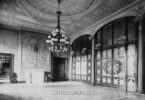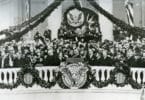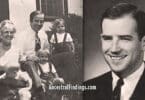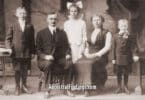As we continue climbing through the history of American presidents, we reach John F. Kennedy, a leader whose youth, charisma, and tragic end turned him into a cultural icon. Often remembered as a symbol of hope and progress, Kennedy’s presidency brought both achievements and controversies, set against a backdrop of Cold War tensions and rapid social change. Let’s examine the Kennedy family’s deep-rooted legacy, JFK’s presidency, and the impact that continues to resonate with Americans today.
Family Background: The Kennedys, America’s Political Dynasty
John Fitzgerald Kennedy was born on May 29, 1917, in Brookline, Massachusetts, into a family that would become one of America’s most famous political dynasties. His father, Joseph P. Kennedy Sr., was a successful businessman and political figure, serving as the U.S. Ambassador to the United Kingdom. Known for his ambition, Joseph hoped to see his sons reach the highest offices in the American government. His mother, Rose Fitzgerald Kennedy, came from another prominent political family; her father, John F. “Honey Fitz” Fitzgerald, was a well-known mayor of Boston.
JFK was one of nine siblings, all of whom were encouraged to pursue excellence. His older brother, Joseph Jr., was initially expected to fulfill their father’s political aspirations, but after his tragic death in World War II, that responsibility fell to John. This family legacy of public service and high expectations shaped JFK’s sense of purpose and drive for achievement.
Military Service and Family Life
After graduating from Harvard University, Kennedy joined the U.S. Navy and served with distinction during World War II. He commanded a patrol torpedo boat in the Pacific, where he was injured in combat and was awarded the Navy and Marine Corps Medal for bravery. This experience solidified his sense of duty and contributed to the image of Kennedy as a war hero, an image that would later bolster his political career.
In 1953, JFK married Jacqueline Lee Bouvier, a sophisticated, intelligent woman who became one of the most admired first ladies in American history. Together, they had four children, though only two—Caroline and John Jr.—survived to adulthood. The Kennedys’ life in the White House became known as “Camelot,” evoking a sense of idealism, glamour, and possibility that captivated the American public.
Learning About Kennedy’s Strengths in His Presidency
Kennedy’s presidency, from 1961 until his assassination in 1963, was marked by bold initiatives and complex challenges. Let’s learn more about him through the key strengths that defined his leadership:
• The Space Race: One of Kennedy’s most ambitious goals was to put an American on the moon. In 1961, he announced the goal of landing a man on the moon by the end of the decade, inspiring a nation and accelerating the U.S. space program. Although he did not live to see it realized, his vision led to the successful Apollo 11 mission in 1969, marking a triumph in the space race.
• The Peace Corps: In an effort to foster global goodwill, Kennedy established the Peace Corps, an organization that sent American volunteers abroad to aid developing countries. This initiative not only promoted peace and cooperation but also provided Americans with a way to serve their country beyond military roles, reinforcing Kennedy’s commitment to humanitarian values.
• Civil Rights Support: While Kennedy was initially cautious on civil rights, he grew more supportive over time. In 1963, he proposed comprehensive civil rights legislation, laying the groundwork for what would become the Civil Rights Act of 1964. His public stance on equality and his moral support of the movement helped propel the cause forward.
• Diplomatic Strategies During the Cold War: Kennedy’s handling of the Cuban Missile Crisis in 1962 is widely seen as one of his greatest accomplishments. Through careful diplomacy, he successfully negotiated a peaceful resolution with Soviet Premier Nikita Khrushchev, avoiding nuclear war and demonstrating restraint and strategic thinking during one of the Cold War’s most perilous moments.
Understanding Kennedy’s Limitations in His Presidency
While Kennedy achieved notable successes, his presidency was also marked by limitations and challenges. Let’s take a closer look at these aspects of his leadership:
• Bay of Pigs Invasion: One of the major setbacks of Kennedy’s presidency was the failed Bay of Pigs invasion in 1961, an attempt to overthrow Fidel Castro’s government in Cuba. The operation, which involved training Cuban exiles to invade Cuba, was poorly executed and quickly defeated. The failure embarrassed the United States and strengthened Castro’s alliance with the Soviet Union.
• Initial Hesitation on Civil Rights: While Kennedy eventually supported civil rights, his initial approach was often viewed as cautious and politically calculated. Critics argue that he could have acted more decisively and sooner, especially given the racial tensions and violence that characterized the early 1960s.
• Escalation in Vietnam: Although Kennedy aimed to limit U.S. involvement in Vietnam, he authorized the deployment of military advisers, laying the groundwork for what would eventually become a full-scale American commitment under his successors. His role in escalating the conflict remains a point of debate among historians.
• Health Issues and Secrecy: Kennedy’s health was an often-concealed challenge during his presidency. He suffered from Addison’s disease and chronic back pain, requiring regular medication and treatment. The secrecy around his health led to questions about transparency and whether the public deserved a fuller understanding of the leader’s physical condition.
The Tragic End and Enduring Legacy of Camelot
On November 22, 1963, Kennedy’s life and presidency were tragically cut short when he was assassinated in Dallas, Texas. His death shocked the nation and the world, creating a profound sense of loss and abruptly ending what many viewed as a hopeful chapter in American history. Kennedy’s youth, charisma, and untimely death contributed to a mythologized view of his presidency, often referred to as “Camelot”—a term his widow, Jacqueline, popularized after his death to evoke the idealism and spirit of his time in office.
Kennedy’s children, Caroline and John Jr., carried on his legacy in different ways, though John Jr.’s life was also cut short in a plane crash in 1999. Caroline remains active in public service, continuing the family tradition of leadership and advocacy. The Kennedy family has continued to inspire Americans with their commitment to public service and the values of Camelot.
Legacy: Strengths and Limitations in Perspective
John F. Kennedy’s presidency remains one of the most widely discussed and analyzed in American history. His strengths—such as his vision for space exploration, support for civil rights, and strategic diplomacy during the Cuban Missile Crisis—demonstrated a forward-thinking approach that resonated with a generation eager for progress. However, his presidency also faced significant challenges, from the failure of the Bay of Pigs to the early stages of the Vietnam conflict.
Despite these limitations, Kennedy’s legacy symbolizes hope and inspiration. His call for Americans to “ask not what your country can do for you—ask what you can do for your country” continues to echo in American culture. The Kennedy legacy lives on as an ideal of service, patriotism, and possibility, a lasting reminder of a young leader who captured the spirit of his time and left a vision for the future.
To gain a comprehensive understanding of John F. Kennedy’s life, presidency, and enduring legacy, consider the following biographies:
An Unfinished Life: John F. Kennedy, 1917-1963
Authored by Robert Dallek, this biography offers an in-depth exploration of Kennedy’s personal and political life, providing a balanced perspective on his leadership and legacy.
JFK: Coming of Age in the American Century, 1917-1956
Fredrik Logevall presents a detailed account of Kennedy’s early years, examining the influences that shaped his character and political ambitions.
Michael O’Brien provides a comprehensive look at Kennedy’s life, delving into his family background, career, and the complexities of his presidency.
The Road to Camelot: Inside JFK’s Five-Year Campaign
Thomas Oliphant and Curtis Wilkie explore the strategic planning and efforts behind Kennedy’s path to the presidency, offering insights into his political acumen.
Written by Kennedy himself, this Pulitzer Prize-winning book profiles acts of bravery and integrity by eight U.S. senators, reflecting the values he admired.These biographies provide diverse perspectives on Kennedy’s life, leadership, and the lasting impact of his presidency.






